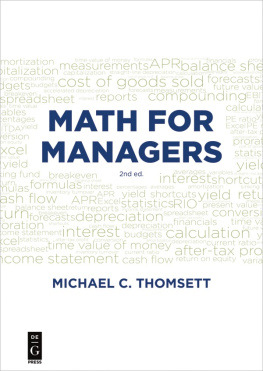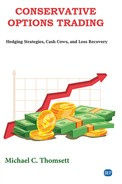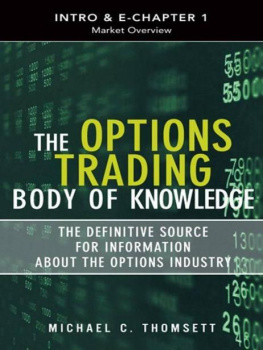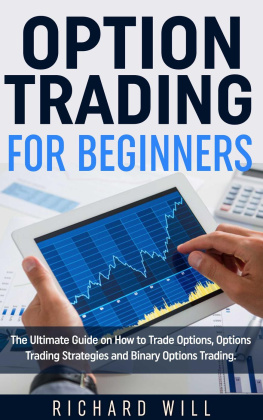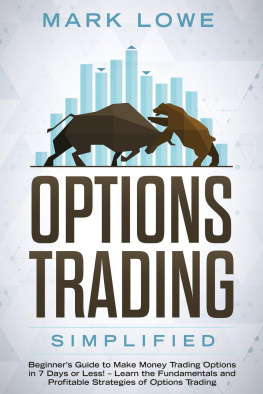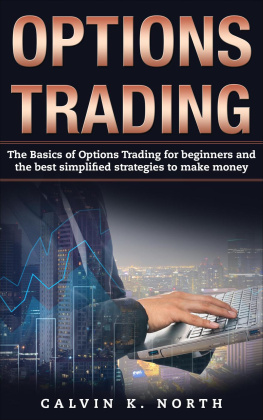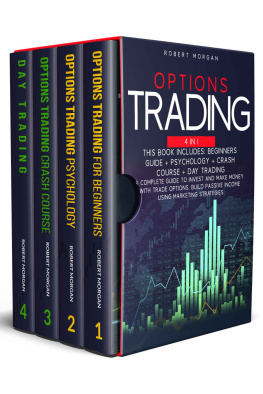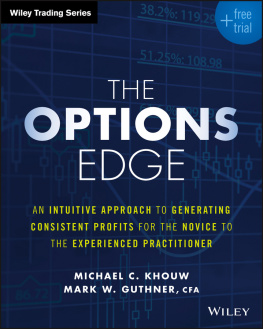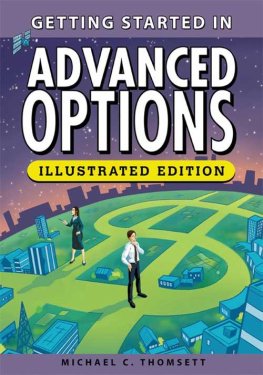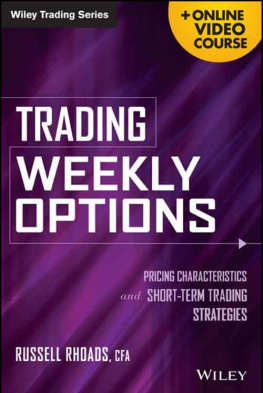Making Money With Option Strategies
Making Money With Option Strategies
Powerful Hedging Ideas for the Serious Investor to Reduce Portfolio Risks
By Michael C. Thomsett

Copyright 2016 by Michael C. Thomsett
All rights reserved under the Pan-American and International Copyright Conventions. This book may not be reproduced, in whole or in part, in any form or by any means electronic or mechanical, including photocopying, recording, or by any information storage and retrieval system now known or hereafter invented, without written permission from the publisher, The Career Press.
MAKING MONEY WITH OPTION STRATEGIES
EDITED BY JODI BRANDON
TYPESET BY DIANA GHAZZAWI
Cover image: Nick M. Do/istock
Cover design by Rob Johnson/Toprotype
Printed in the U.S.A.
To order this title, please call toll-free 1-800-CAREER-1 (NJ and Canada: 201-848-0310) to order using VISA or MasterCard, or for further information on books from Career Press.

The Career Press, Inc.
12 Parish Drive
Wayne, NJ 07470
www.careerpress.com
Library of Congress Cataloging-in-Publication Data
CIP Data Available Upon Request.
Contents
Introduction Solving the Time and Proximity Issues
O ptions trading is a paradox.
It can be highly speculative or highly conservative, or both, depending on when and how it is used. This paradox can be employed to respond to the unceasing symptom of investing in the stock market: Those who buy shares of stock worry, no matter how price moves. If price moves up, should you take profits now? If price moves down, should you cut your losses or buy more shares? Owning stock is a troubling activity because of the uncertainties it involves. Optionswith the paradox they bring to the picturecan solve some of the risk issues for you.
A lot of focus in the market is on short-term trading opportunities, and these exist without any doubt. However, the more permanent value of options trading is not in short-term profit potential, but in how options can reduce risk in your portfolio. At the same time, reducing risk and generating income is an elegant combination of features. The flexibility of options is the great advantage; as a hedge against risk, an options position can also generate income and enable you to take profits without needing to sell shares. For most traders, identifying high-risk versus low-risk strategies is where emphasis is placed. This is not a simple matter, because the rapidly changing stock and options markets define emerging risks and opportunities that change from day to day and even from minute to minute. Within this ever-changing situation, todays high-risk option can be tomorrows low-risk solution.
This suggestionthat risk is situational and not position-specificis one way to look at options. In this book, the idea is demonstrated through examination of strategies designed to hedge positions, reduce risk, and generate income.
The distinction between speculative and conservative is not merely an issue of which strategy you employ, but when and in what proximity a price is found. Proximity in this sense refers to how close the strike of an option (the price at which it can be bought or sold) is to the current price of the underlying stock. It also refers to how close price is to the top (resistance) or bottom (support) of the trading range.
Reversal is most likely to occur when price is close to resistance or support, especially when price moves through these range borders. Reversal back into range is very likely; the trading range brings structure to the price chart, and significant events such as breakout above resistance or below support point the way to trading opportunities.
This is where options play a role.
of this book begins with a summary of the basics: terminology, terms of each option, and how trading works. For many traders, this is familiar ground, but for many more it is new and perhaps even mysterious. The purpose of this chapter is to set the foundation for understanding options. Because these are complex trading devices with exotic jargon and rules, many traders just stay away. But this means they miss opportunities to reduce risk and manage portfolio exposure in all types of markets.
Throughout the book, as terms are introduced for the first time, they are shown in boldface and italics. Every term is also defined in the glossary at the end of the book.
The next topic is hedging, covered in . The moneyness of options (referring to the fixed strike price versus ever-changing value of the underlying stock) is one element in valuation. The other element is time remaining until the expiration of the option.
offers an examination of the differences between speculation with options and conservative application of options. Unlike most products, options cover the entire risk range and can be tailored to fit any risk profile. In this book, the assumed profile is that of an investor with a portfolio of stocks, whose interest is in developing conservative hedging strategies.
Following this, explains charting and trade timing. Though this topic is usually of interest only to day traders and swing traders, even a buy-and-hold investor benefits by being able to recognize the exaggerated price movement of a stock in specific circumstances; for example, after an earnings surprise, price tends to overreact, only to correct itself within two to three sessions. Knowing this, a conservative investor can use options to create short-term income and even out the momentary price movementsall with little risk.
strategy, including covered calls, knowing the risks before entering the strategy is essential as part of a conservative strategy.
An interesting twist on covered calls is introduced in . The uncovered put seems at first glance to be the opposite of a covered call. In fact, it is in many ways an identical strategy with the same market risks. This chapter explains the risks of uncovered puts and compares them to the covered call.
In , the discussion is expanded with introduction of the spread. This is the simultaneous opening of two different options with dissimilar strikes, expiration dates, or both. The risk levels vary considerably, so the full range of spread types is explained here with careful attention paid to the risk level and where spreads help you to manage your portfolio positions.
expands on the basic spread with an examination of two types: the butterfly and the condor. Both are described in this section as 1-2-3, a reference to opening of three different positions with different expiration dates. This is an advanced set of strategies, but for those willing to monitor positions, they can offer a variation on the portfolio that introduces some interesting cash-generation possibilities.
introduces more variations: collars and synthetic stock hedges. These present opportunities to cap risks when stock prices turn volatile.
explains how straddles work. These are viewed by many investors as overly risky, but they do not have to be. These devicesopening two options with the same strike and expiration datecan be designed to provide potential profits with minimum risks.
explains the roll, a technique in which one option is closed and another opened with a later expiration date. This is done to avoid exercise. The roll is appropriate in many circumstances, but not in all.
Next page


